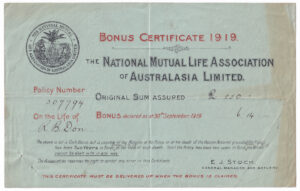[Editor: This insurance certificate, issued by the National Mutual Life Association of Australasia, was printed in 1919.]

The National Mutual Life Association of Australasia Limited.
Policy Number: 307794
On the Life of: R. B. Don
Original Sum assured 250 – –
Bonus declared as at 30th September, 1919 6 14 –
The above is not a Cash Bonus, but is payable at the Maturity of the Policy or at the death of the Person Assured, provided the Policy has been Two Years in force from 3.7.18 at the date of such death. Until the Policy has been two years in force from 3.7.18 the Bonus cannot be dealt with in any way
The Association reserves the right to correct any error in this Certificate
E. J. Stock,
General Manager and Actuary.
This certificate must be delivered up when the bonus is claimed.
Source:
Original document
Editor’s notes:
Dimensions (approximate): 226 mm. (width), 144 mm. (height).
The handwritten text in this document has been rendered in italics.
The reverse side of this certificate is blank.
Leave a Reply